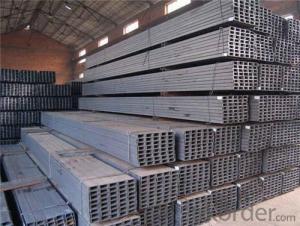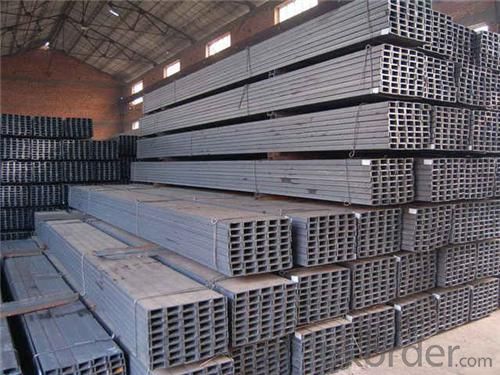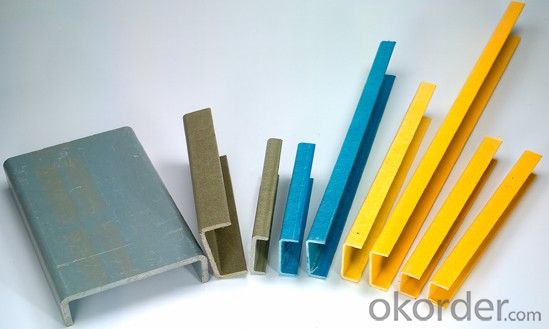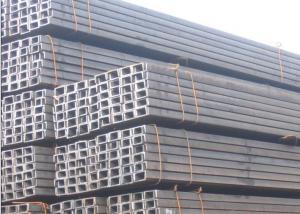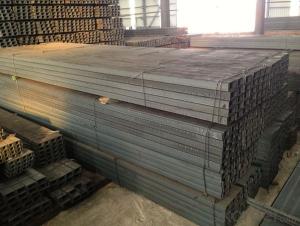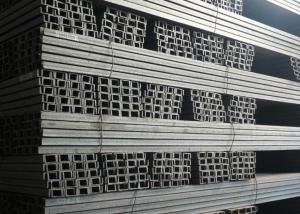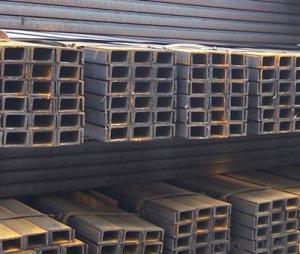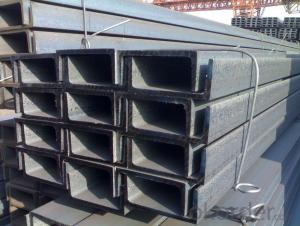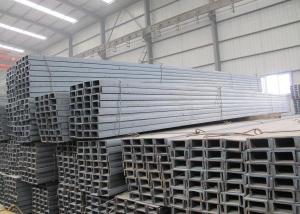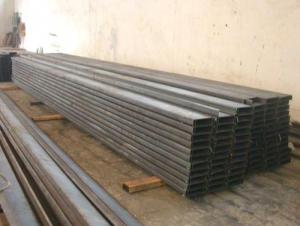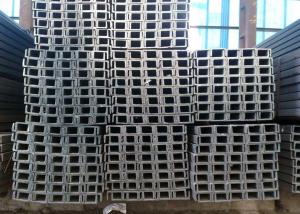Widely Used C Channel Steel JIS Standard
- Loading Port:
- Qingdao
- Payment Terms:
- TT OR LC
- Min Order Qty:
- 2000 PCS
- Supply Capability:
- 38000 PCS/month
OKorder Service Pledge
OKorder Financial Service
You Might Also Like
Widely Used C Channel Steel JIS Standard Details
| Standard: | AISI,ASTM,BS,DIN,GB,JIS | Dimensions: | 50-320mm | Grade: | Q235B,SM490,SS400,Q235B,Q345 ,Q345B |
| Place of Origin: | China (Mainland) | Brand Name: | CNBM | Model Number: | 50-320mm |
| Shape: | U Channel | Application: | Construction, handrail, windows, machinery, telecome, curtain wall | Perforated Or Not: | Is Perforated |
| Length: | 6m-12m, by customer's requiremnts | Thickness: | 4.5-9.5mm | Surface treatment: | Galvanized, Painted, Oil |
| Technique: | Hot rolled | Surface processing: | you can Galvanized, coated, or as your request | Width: | 37-88mm |
| Height: | 50-320mm | Alloy or not: | Non-alloy | Zinc coating: | 15-80um or 120-600g/m2 |
Packaging & Delivery
| Packaging Detail: | 1.Big OD:in bulk 2.Small OD:packed by steel strips 3.woven cloth with 7 slats for c channel steel jis standard |
| Delivery Detail: | 3-15 working days for c channel steel jis standard |
Widely Used C Channel Steel JIS Standard Specifictions
Product | Widely used c channel steel jis standard |
Internatioanal Standard | ISO 9001-2008 / ISO 630 / JIS / ASTM |
Standards | ASTMA53/ASTM A573/ASTM A283/Gr.D/ BS1387-1985/ GB/T3091-2001,GB/T13793-92, ISO630/E235B/ JIS G3101/JIS G3131/JIS G3106/ |
Materials | Q195,Q215,Q235B,Q345B, S235JR/S235/S355JR/S355 SS440/SM400A/SM400B |
Product Category | Metallurgy,Mineral &Energy |
Technique | HOT ROLLED |
Packing | 1.Big OD:in bulk2.Small OD:packed by steel strips3.woven cloth with 7 slats4.according to the requirements of customers |
Usage | Mechanical&manufacture,Steel strcuture,Shipbuilding,Bridging,Automobile chassis |
Main market | Middle East,Africa, Asia and some Uropean country and America ,Australia |
Country of origin
| China |
Productivity | 300000 Metric Tons pet year |
Remark | Payment terms :T/T ,L/CTerms of trade :FOB ,CFR,CIF ,DDP,EXWMinimum order : 25 tonsLead time :on or before 3-15 working days . |
Size
| l Height:50-320mml Width: 37-88mm l Thickness:4.5-9.5mm l Length:6-12meters |
Logo | Jinan Sino Steel shipping mark or your company logo |
Another Name | u channel steel, channel steel, steel channel |
Surface processing | you can Galvanized,coated,or as your request |
Technical | Hot rolled mild steel |
you Can | Customized Sizes, GalvanizedAnd punching |
Further treatment | We can provide cutting, painting, drilling holes, bending, threading, welding, galvanization, packing etc , which makes that we can supply the most professional and best sevice for you. |
Widely Used C Channel Steel JIS Standard Pictures
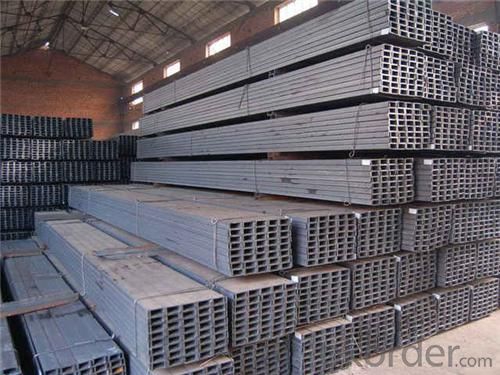

- Q: What are the different methods for designing steel channels for high wind loads?
- There are several methods for designing steel channels for high wind loads. One common approach is to use the Load and Resistance Factor Design (LRFD) method, which takes into account the applied loads, such as wind pressure, and the resistance of the steel channel. Another method is the Allowable Stress Design (ASD) method, which uses a factor of safety to determine the maximum permissible stress in the steel channel. Additionally, computer-aided design (CAD) software can be utilized to analyze and optimize the structural performance of steel channels under high wind loads.
- Q: How do steel channels perform in seismic conditions?
- Due to their superior strength and durability, steel channels are widely used in construction projects. They have proven to be highly effective in providing structural stability and resistance against earthquakes. One major advantage of steel channels in seismic conditions is their ability to flex and dissipate energy during an earthquake. This flexibility allows the channels to absorb seismic forces and prevent significant damage to the overall structure. Steel channels are designed to bend and deflect under stress, distributing seismic energy throughout the entire building system. Additionally, steel channels have high stiffness and strength, enabling them to withstand lateral forces generated during an earthquake. Their rigidity helps maintain the structural integrity of the building, reducing the risk of collapse or severe damage. Steel channels are also known for their excellent ductility, meaning they can deform without breaking. This property is highly beneficial in seismic conditions as it allows the channels to absorb and dissipate seismic energy without undergoing brittle fracture. This enhances the safety of the structure and provides a higher level of resilience against earthquakes. Moreover, steel channels can be easily reinforced and retrofitted to improve their seismic performance. Additional bracing or diagonal members can be installed to further enhance the strength and stiffness of the structure. This adaptability makes steel channels suitable for both new construction projects and retrofitting existing structures to meet seismic codes. In conclusion, steel channels are highly effective in seismic conditions. Their flexibility, strength, ductility, and adaptability make them a preferred choice for structures in earthquake-prone areas. By effectively absorbing and dissipating seismic energy, steel channels provide enhanced structural stability, minimizing the risk of damage or collapse during an earthquake.
- Q: Can steel channels be used in infrastructure projects?
- Yes, steel channels can be used in infrastructure projects. Steel channels are a versatile and commonly used structural component in construction and infrastructure projects. They are often used to provide support and stability to various structures, such as bridges, buildings, and highways. Steel channels offer several advantages that make them suitable for infrastructure projects. Firstly, they have high strength and durability, which makes them capable of withstanding heavy loads and extreme weather conditions. This ensures the long-term integrity and stability of the infrastructure. Additionally, steel channels can be easily fabricated and customized to meet specific project requirements. They are available in various sizes, shapes, and thicknesses, allowing engineers and architects to design and construct structures with precision. Furthermore, steel channels have excellent corrosion resistance properties. This is crucial in infrastructure projects, especially those exposed to moisture or harsh environmental conditions. Steel channels can be galvanized or coated with protective layers to prevent rust and corrosion, thereby extending their lifespan. Moreover, steel channels provide cost-efficiency. Compared to other construction materials, such as concrete or wood, steel channels have a longer lifespan and require less maintenance. This reduces the overall maintenance and replacement costs of infrastructure projects, making them a cost-effective choice. In conclusion, steel channels are widely used in infrastructure projects due to their strength, durability, customization options, corrosion resistance, and cost-efficiency. They play a crucial role in providing support and stability to various structures, making them a reliable choice for engineers and architects involved in infrastructure development.
- Q: What are the weight calculations for steel channels?
- The weight calculations for steel channels depend on the dimensions and type of channel being used. To calculate the weight of a steel channel, you would typically multiply the cross-sectional area of the channel by the density of steel. The cross-sectional area can be calculated using the height, width, and thickness of the channel. It is important to consult engineering references or use specialized software to accurately determine the weight of steel channels based on their specific dimensions and specifications.
- Q: What are the different tolerances for steel channels?
- The different tolerances for steel channels can vary depending on the specific standards and specifications set by the manufacturing industry or the project requirements. Generally, tolerances for steel channels are specified in terms of dimensional measurements such as width, depth, and length. For example, the width and depth tolerances for steel channels are typically defined by a range of acceptable measurements. This range accounts for slight variations in the dimensions of the channel, ensuring that it still satisfies the required specifications while allowing for manufacturing variations. The length tolerance for steel channels can also be specified to ensure that the final product meets the desired length requirements. This could include tolerances for both the overall length of the channel as well as any specific lengths required for certain sections or cuts. In addition to dimensional tolerances, other factors such as surface finish and straightness may also be specified. Surface finish tolerances may dictate the acceptable level of smoothness or roughness on the surface of the steel channel. Straightness tolerances may define how much deviation from a straight line is permissible for the channel. It is important to note that the specific tolerances for steel channels can vary depending on the industry, application, and the standards being followed. Therefore, it is always necessary to refer to the relevant standards or project specifications to determine the precise tolerances for a particular steel channel.
- Q: What are the different surface finishes available for painted steel channels?
- Painted steel channels come in a variety of surface finishes, each with its own purpose and aesthetic appeal. The most common finishes include: 1. Smooth finish: This is the standard and widely used finish for painted steel channels. It provides a sleek and polished appearance with a glossy surface. 2. Matte finish: For a more subdued and contemporary look, a matte finish is ideal. It offers a non-reflective surface and is often used to minimize glare. 3. Textured finish: Textured finishes add depth and dimension to the steel channels. This can be achieved through techniques like embossing or sandblasting, resulting in visually interesting and tactile textures. 4. Hammered finish: By creating small indentations on the surface, a hammered finish gives the steel channels a rustic and distinctive appearance, resembling hammered metal. 5. Patterned finish: Patterned finishes involve applying specific designs or patterns onto the channels. Techniques like stenciling or laser etching can be used to achieve intricate and eye-catching designs, allowing for endless customization possibilities. 6. Metallic finish: Adding metallic pigments to the paint creates a shiny and reflective surface. This luxurious finish is often used when a touch of elegance is desired. It's important to consider that the availability of these finishes may vary depending on the manufacturer or supplier of the steel channels. The choice of finish may also depend on the intended use and the desired overall aesthetic of the project.
- Q: What is the difference between channel steel and C steel?
- Channel steel is rail steel, relatively thick. C steel is rolled by iron plate
- Q: Do steel channels have any specific acoustic properties?
- Yes, steel channels do have specific acoustic properties. Due to their rigid structure and dense material, steel channels are known for their high sound transmission loss, providing effective sound insulation. Additionally, they exhibit low resonance and vibration, reducing the potential for noise amplification or distortion. These acoustic properties make steel channels a preferred choice in various applications that require sound control and acoustic performance.
- Q: Are steel channels suitable for temporary structures?
- Yes, steel channels can be suitable for temporary structures. Steel channels are commonly used in construction for their strength and durability. They are versatile and can be easily fabricated and assembled to create temporary structures such as scaffolding, shoring, and temporary supports. Steel channels provide stability and load-bearing capacity, making them ideal for supporting temporary structures during construction or event setups. Additionally, steel channels are resistant to weathering and can withstand heavy loads, ensuring the safety and stability of the temporary structure.
- Q: What are the different cross-sectional shapes of steel channels?
- Steel channels are commonly used structural components that are available in various cross-sectional shapes. The different shapes of steel channels include C channels, U channels, and Z channels. C channels, also known as C-sections or C beams, have a distinctive C-shaped profile. They have a wide top and narrow bottom, with two flanges extending outwards at a right angle from the web. C channels are commonly used in construction and engineering applications, providing structural support and stability. U channels, also referred to as U-sections or U beams, have a U-shaped profile. They have parallel flanges that are connected by a web in the middle. U channels are widely used in manufacturing and industrial applications, particularly in conveyor systems, support structures, and framing. Z channels, also known as Z-sections or Z beams, have a Z-shaped profile. They have a vertical web with two flanges that are angled outward in opposite directions. Z channels are often used in construction and architectural applications, providing strength and stability in various structural elements like roof purlins and wall studs. Each of these cross-sectional shapes has its own unique characteristics and advantages, making them suitable for different applications. The choice of steel channel shape depends on factors such as load-bearing requirements, structural design, and specific project needs.
Send your message to us
Widely Used C Channel Steel JIS Standard
- Loading Port:
- Qingdao
- Payment Terms:
- TT OR LC
- Min Order Qty:
- 2000 PCS
- Supply Capability:
- 38000 PCS/month
OKorder Service Pledge
OKorder Financial Service
Similar products
Hot products
Hot Searches
Related keywords
